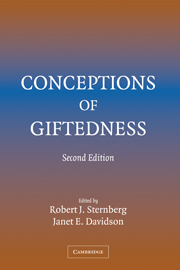Crossref Citations
This Book has been
cited by the following publications. This list is generated based on data provided by Crossref.
Sternberg, Robert J.
1986.
Identifying the gifted through IQ: Why a little bit of knowledge is a dangerous thing.
Roeper Review,
Vol. 8,
Issue. 3,
p.
143.
Stoeger, Heidrun
and
Ziegler, Albert
2005.
Motivational Orientations and Cognitive Abilities: An Empirical Investigation in Primary School.
Gifted and Talented International,
Vol. 20,
Issue. 2,
p.
7.
Phillipson, Shane N.
2005.
International Handbook of Intelligence: Lighting Candles on a Spaceship: The Search for Giftedness.
Gifted and Talented International,
Vol. 20,
Issue. 2,
p.
83.
Beghetto, Ronald A.
and
Plucker, Jonathan A.
2006.
Creativity and Reason in Cognitive Development.
p.
316.
Lidz, Carol S.
and
Elliott, Julian G.
2006.
Use of Dynamic Assessment with Gifted Students.
Gifted Education International,
Vol. 21,
Issue. 2-3,
p.
151.
Koshy, Valsa
and
Robinson, Nancy M.
2006.
Too long neglected: Gifted young children.
European Early Childhood Education Research Journal,
Vol. 14,
Issue. 2,
p.
113.
Henshon, Suzanna E.
2007.
High‐ability perspectives from a prominent investigator and gatekeeper:An interview with Tracy L. Cross.
Roeper Review,
Vol. 29,
Issue. 3,
p.
153.
Heller, Kurt A.
2007.
Scientific ability and creativity.
High Ability Studies,
Vol. 18,
Issue. 2,
p.
209.
Sternberg, Robert J.
2007.
Cultural concepts of giftedness.
Roeper Review,
Vol. 29,
Issue. 3,
p.
160.
Helland, Håvard
2007.
How does social background affect the grades and grade careers of Norwegian economics students?.
British Journal of Sociology of Education,
Vol. 28,
Issue. 4,
p.
489.
Anders Ericsson, K.
Roring, Roy W.
and
Nandagopal, Kiruthiga
2007.
Giftedness and evidence for reproducibly superior performance: an account based on the expert performance framework.
High Ability Studies,
Vol. 18,
Issue. 1,
p.
3.
Sternberg, Robert Jeffrey
2008.
Increasing Academic Excellence and Enhancing Diversity Are Compatible Goals.
Educational Policy,
Vol. 22,
Issue. 4,
p.
487.
Burney, Virginia H.
2008.
Applications of Social Cognitive Theory to Gifted Education.
Roeper Review,
Vol. 30,
Issue. 2,
p.
130.
Sak, Ugur
2008.
Test of the Three-Mathematical Minds (M3) for the Identification of Mathematically Gifted Students.
Roeper Review,
Vol. 31,
Issue. 1,
p.
53.
Preckel, Franzis
Goetz, Thomas
Pekrun, Reinhard
and
Kleine, Michael
2008.
Gender Differences in Gifted and Average-Ability Students.
Gifted Child Quarterly,
Vol. 52,
Issue. 2,
p.
146.
Sparfeldt, Jörn R.
Wirthwein, Linda
and
Rost, Detlef H.
2009.
Hochbegabt und einfallslos?.
Zeitschrift für Pädagogische Psychologie,
Vol. 23,
Issue. 1,
p.
31.
Sekowski, Andrzej
Siekanska, Malgorzata
and
Klinkosz, Waldemar
2009.
International Handbook on Giftedness.
p.
467.
Reis, Sally M.
and
Renzulli, Joseph S.
2009.
Myth 1: The Gifted and Talented Constitute One Single Homogeneous Group and Giftedness Is a Way of Being That Stays in the Person Over Time and Experiences.
Gifted Child Quarterly,
Vol. 53,
Issue. 4,
p.
233.
Sternberg, Robert J.
2009.
The Rainbow and Kaleidoscope Projects.
European Psychologist,
Vol. 14,
Issue. 4,
p.
279.
Renzulli, Joseph S.
Siegle, Del
Reis, Sally M.
Gavin, M. Katherine
and
Reed, Rachael E. Sytsma
2009.
An Investigation of the Reliability and Factor Structure of Four New Scales for Rating the Behavioral Characteristics of Superior Students.
Journal of Advanced Academics,
Vol. 21,
Issue. 1,
p.
84.



